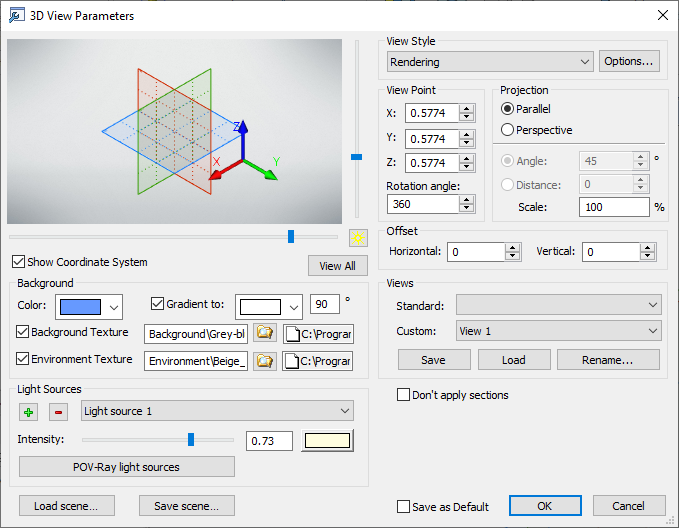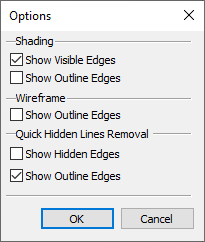3D View Parameters |
  
|
Call the command:
Icon |
Ribbon |
|---|---|
|
View > Properties |
Keyboard |
Textual Menu |
<PW> |
View > Properties |
The command can also be called from the contextual menu invoked by clicking ![]() on an empty space in the 3D scene.
on an empty space in the 3D scene.
After calling the command, a dialog window appears, which contains all current 3D view parameters.

Preview
The 3D window contents preview pane is on the left-hand side of the dialog window. It displays all the same as in the master 3D window, but smaller. You can work with the image in the preview pane in the same way as with the image in the 3D view window: spin, pan, zoom.
To quickly view the contents of the 3D scene, you can use the View All button - clicking it scales the image in such a way that all contents of the 3D scene are visible. All manipulations made in the preview pane will be also applied to the image in the 3D view window (after closing its parameters dialog).
The Show Coordinate System flag can be used for disabling the coordinate system display in the 3D view window.
Background
The Background group of parameters defines the background color of the 3D view window. To achieve a smooth transition of colors, set the Gradient to flag and specify two colors by selecting from drop-down lists. Clear the flag in order to make the 3D view window background monochrome. In such a case, specify just one Color).
The Background Texture flag is used to enable/disable the mode of using the texture as a background of the 3D view window. When the flag is disabled the 3D view window has the color that is specified in the background parameters.
The Environment Texture flag is used to enable/disable the mode of using the texture as environment for 3D model. When the flag is disabled the specified texture will be suppressed.
The group of parameters in the lower-left corner of the dialog window is provided to manage light sources attached to the active camera in the 3D scene. This group includes the list of dynamic Light sources existing in the current 3D window, buttons for adding/deleting light sources attached to the camera, as well as control elements for defining parameters of each of the light sources.
To edit parameters of an existing light source, select this source in the drop-down list. Control elements located below the list allow changing the brightness (Intensity) of the selected light source (using the slider or numerically), as well as its color. The selected light source can be deleted by clicking the button ![]() . Clicking the
. Clicking the ![]() button creates another directional light source attached to the active camera.
button creates another directional light source attached to the active camera.
The position of the selected light source with respect to the camera is defined using sliders located at the right and below the viewing pane of the 3D window contents. By default, dynamic light sources are placed directly on the camera (the sliders being positioned in the middle of their respective scales). By moving the sliders away from the center of the scale, one can move light sources right/left and up/down with respect to the camera. The ![]() button brings the light source back to the camera.
button brings the light source back to the camera.
Importing/Exporting 3D view Parameters
Load scene and Save scene buttons can be used for working with scene preset files. Scene parameters can be exported to a special file in the .tfscene format for further usage. Such file contains coloring. textures and light sources parameters.
Use the Save scene button to create a preset file. Use Load scene button to load an existing preset file. You can also drag and drop preset files from windows explorer or other sources to 3D scene. Several presets are supplied with the T-FLEX.
View Style
The method of the 3D scene rendering in this 3D window is defined using the View Style group of parameters. The drop-down list lets you select the desired method, while the Options button serves for defining additional parameters of each mode. Clicking this button brings up the Options dialog, which specifies the requirements on drawing various lines of the 3D model - edges, outline (silhouette), hidden lines - for each visualization method.

View point, Projection and Offset
The View point, Projection and Offset groups of parameters define the view direction and the method of projecting from the system camera, as well as its distance from the center of the 3D scene. In the parallel projecting method, the camera distance is defined by the Scale parameter. This parameter defines the degree of zooming on the image in the 3D scene.
In the perspective projection, the camera distance can be defined either by the field of view angle of the 3D scene, or directly by the distance between the camera and the center of the 3D scene. All three parameters are defined numerically. Additionally, the scale and the field of view angle can be controlled using the mouse, directly in the preview pane of this dialog, similar to the way it is done in the 3D window itself when moving/rotating the camera. The Offset parameter defines the horizontal and vertical shift of the 3D scene center with respect to the camera.
The Views group of parameters, located in the lower-right corner of the dialog, serves for quick setup of the system camera orientation.
The Standard drop-down list lets you changing the view direction of the system camera according to one of the standard view points. For this, simply select the desired view point in the list.
The Custom drop-down list serves for handling custom 3D views saved in the system.
A custom view can be loaded (that is, the 3D window set up according to the information stored in the 3D view), saved (by writing 3D View information about the current state of the 3D window) and renamed. To load a 3D view, select this 3D view in the list and click the Load button. Clicking the Save button writes information about the current state of the 3D window in the 3D View selected in the Custom list. Clicking the Rename… button calls an additional dialog for defining a new name for the selected 3D view.
Keep in mind that unlike standard views, selecting a custom view in the list doesn't apply this view. You have to use the Load button for it.
Background and Environment Textures are not saved when saving views.
Don't apply sections. Enabling this flag prevents applying sections in the current 3D window. It is useful when you work with several 3D windows and want to have a section in one window and full model in another window.
Save as Default. If this checkbox is enabled, the loaded (using the Load button) standard or custom view will be applied by default to all new 3D windows in the current document after clicking OK.
A view is applied with parameters that were present upon saving a view. If you edit parameters and didn't click the Save button, then upon clicking OK such parameters are applied to the current 3D window only regardless of Save as Default checkbox status.